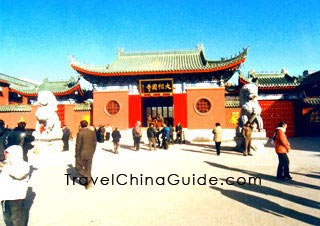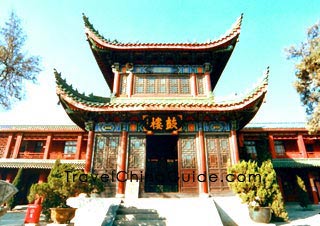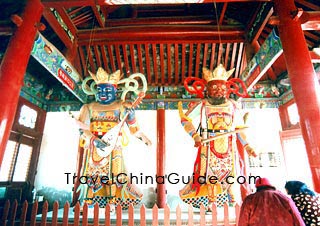Xiangguo Temple
 |
| Xiangguo Temple More Pictures |
The temple was rebuilt in the Tang Dynasty (618-907), and was bestowed the name Xiangguo Temple by Emperor Ruizong. The temple reached its heyday in the Song Dynasty (960-1279). It became an international Buddhism center, attracting many foreign envoys and great monks. It contributed a lot to the cultural exchanges between China and other countries.
Coming here, you will be surprised at the magnificent architecture and the well-arranged layout of the Xiangguo Temple. The existing structures were mainly built in the Qing Dynasty (1644-1911). The buildings include Mountain Gate, Paifang, Heavenly Kings Hall, Daxiongbaodian Hall (Hall of Sakyamuni), Arhat Hall and Sutra Hall. They are set on the north-south central axis with some other annexes built symmetrically on both sides.
Stepping through the gate, you will first see the Bell Tower and Drum Tower as in most Buddhist temples. The bell hanging here weighs five tons and is 2.23 meters (7.3 feet) tall. Its grazioso sound echoes all over the city, especially in winter. Xiangguo Shuang Zhong (the beautiful sound of the bell on a frosty day) is one of the Eight Scenes of Bianjing (nowadays Kaifeng).
|
|
Behind Heavenly Kings Hall is the grandiose Daxiongbaodian Hall (Hall of Sakyamuni), the main hall of the Xiangguo Temple. Three Buddhas are worshiped here. Sakyamuni sits in the middle, Amitabha (Emitofo, guide of the Western Paradise) and Bhaisajyaguru (Yaoshifo, the God of Medicine).
The most remarkable structure in the temple is the Arhat Hall, which is also called Octagonal Glazed Hall. Inside, the towering Octagonal Pavilion houses a wooden statue of Avalokitesvara Bodhisattva, which was carved from the bole of a huge gingko tree during the reign of Emperor Qianlong in the Qing Dynasty. The four sides of the statue are of the same sculpt. On each side, there are six big hands and three to four layers of small fanlike hands, with an eye on each palm. The number of the hands totals 1,048, and likewise the number of the eyes. The statue highly embodies the fine works of the Qing Dynasty. Don't you think it is amazing?
The magnificent two-storey Sutra Hall where the sutras are kept is the last tall building in the temple. It is to the north of Arhat Hall. Glazed lion ornaments line the ridges to the hall, tied with small bells, chiming beautiful music together with the breeze.
In addition, Xiangguo Temple holds annual activities like lantern exhibitions on the Lantern Festival, chrysanthemum exhibitions and the great prayer festival of water and land. On the occasion, pilgrims from home and abroad will assemble here to celebrate the holidays.
| Admission Fee: | CNY 30 |
| Opening Hours: | 07:00 to 19:00 |
| Recommended Time for a Visit: | 40 minutes |
| Bus Route: | 5, 8, 9, 16, 19, 20, 23... |
- Last updated on Jun. 13, 2022 -

